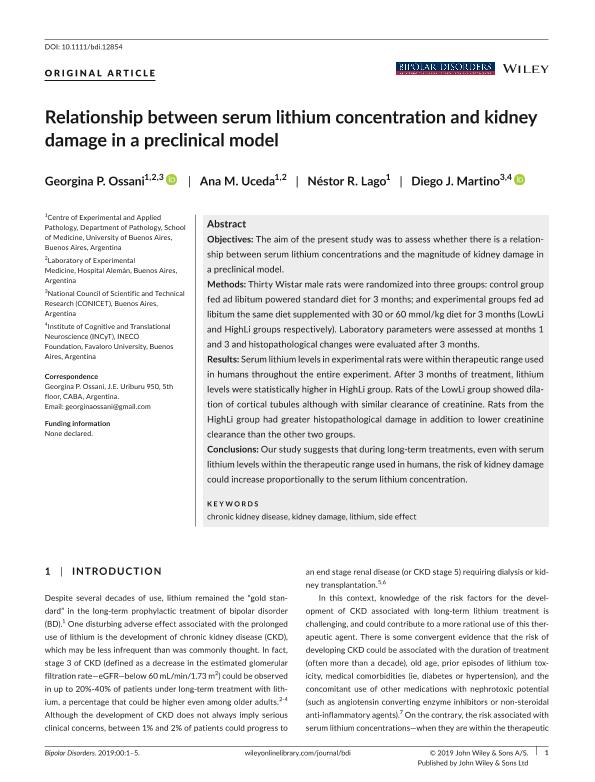Mostrar el registro sencillo del ítem
dc.contributor.author
Ossani, Georgina Paula

dc.contributor.author
Uceda, Ana Margarita

dc.contributor.author
Lago, Néstor R.

dc.contributor.author
Martino, Diego Javier

dc.date.available
2022-09-15T12:03:08Z
dc.date.issued
2020-05
dc.identifier.citation
Ossani, Georgina Paula; Uceda, Ana Margarita; Lago, Néstor R.; Martino, Diego Javier; Relationship between serum lithium concentration and kidney damage in a preclinical model; Wiley Blackwell Publishing, Inc; Bipolar Disorders; 22; 3; 5-2020; 281-285
dc.identifier.issn
1398-5647
dc.identifier.uri
http://hdl.handle.net/11336/168848
dc.description.abstract
Objectives: The aim of the present study was to assess whether there is a relationship between serum lithium concentrations and the magnitude of kidney damage in a preclinical model. Methods: Thirty Wistar male rats were randomized into three groups: control group fed ad libitum powered standard diet for 3 months; and experimental groups fed ad libitum the same diet supplemented with 30 or 60 mmol/kg diet for 3 months (LowLi and HighLi groups respectively). Laboratory parameters were assessed at months 1 and 3 and histopathological changes were evaluated after 3 months. Results: Serum lithium levels in experimental rats were within therapeutic range used in humans throughout the entire experiment. After 3 months of treatment, lithium levels were statistically higher in HighLi group. Rats of the LowLi group showed dilation of cortical tubules although with similar clearance of creatinine. Rats from the HighLi group had greater histopathological damage in addition to lower creatinine clearance than the other two groups. Conclusions: Our study suggests that during long-term treatments, even with serum lithium levels within the therapeutic range used in humans, the risk of kidney damage could increase proportionally to the serum lithium concentration.
dc.format
application/pdf
dc.language.iso
eng
dc.publisher
Wiley Blackwell Publishing, Inc

dc.rights
info:eu-repo/semantics/openAccess
dc.rights.uri
https://creativecommons.org/licenses/by-nc-sa/2.5/ar/
dc.subject
CHRONIC KIDNEY DISEASE
dc.subject
KIDNEY DAMAGE
dc.subject
LITHIUM
dc.subject
SIDE EFFECT
dc.subject.classification
Patología

dc.subject.classification
Medicina Básica

dc.subject.classification
CIENCIAS MÉDICAS Y DE LA SALUD

dc.title
Relationship between serum lithium concentration and kidney damage in a preclinical model
dc.type
info:eu-repo/semantics/article
dc.type
info:ar-repo/semantics/artículo
dc.type
info:eu-repo/semantics/publishedVersion
dc.date.updated
2022-09-15T02:15:59Z
dc.journal.volume
22
dc.journal.number
3
dc.journal.pagination
281-285
dc.journal.pais
Reino Unido

dc.journal.ciudad
Londres
dc.description.fil
Fil: Ossani, Georgina Paula. Universidad de Buenos Aires. Facultad de Medicina. Departamento de Patología. Centro de Patología Experimental; Argentina. Consejo Nacional de Investigaciones Científicas y Técnicas; Argentina. Hospital Alemán. Laboratorio de Medicina Experimental; Argentina
dc.description.fil
Fil: Uceda, Ana Margarita. Hospital Alemán. Laboratorio de Medicina Experimental; Argentina. Universidad de Buenos Aires. Facultad de Medicina. Departamento de Patología. Centro de Patología Experimental; Argentina
dc.description.fil
Fil: Lago, Néstor R.. Universidad de Buenos Aires. Facultad de Medicina. Departamento de Patología. Centro de Patología Experimental; Argentina
dc.description.fil
Fil: Martino, Diego Javier. Consejo Nacional de Investigaciones Científicas y Técnicas. Oficina de Coordinación Administrativa Houssay. Instituto de Neurociencia Cognitiva. Fundación Favaloro. Instituto de Neurociencia Cognitiva; Argentina
dc.journal.title
Bipolar Disorders

dc.relation.alternativeid
info:eu-repo/semantics/altIdentifier/url/https://onlinelibrary.wiley.com/doi/abs/10.1111/bdi.12854
dc.relation.alternativeid
info:eu-repo/semantics/altIdentifier/doi/http://dx.doi.org/10.1111/bdi.12854
Archivos asociados
